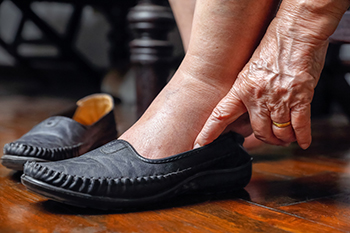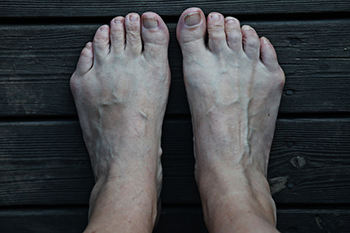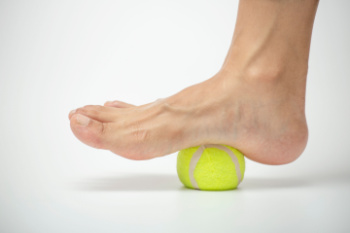Items filtered by date: September 2024
Stop Your Toenail Fungus
Finding Well-Fitting Shoes for Aging Feet

As we age, feet change shape, often becoming wider or flatter due to the loss of fat padding and muscle tone. It is important to ensure shoes provide both comfort and support, fitting snugly without being too wide or narrow. Poorly fitted shoes can worsen issues like osteoarthritis, diabetic nerve damage, hammertoes, bunions, and calluses. Shoes with rubber soles and treads offer the best traction on most surfaces, reducing the risk of falls. Different shoes should be worn for different activities. Supportive walking shoes, for instance, differ from athletic shoes. When shopping for shoes, measure your feet and shop later in the day, when feet are naturally swollen. Shoes should feel immediately comfortable, requiring no breaking in. Proper fit and support can help alleviate foot pain and improve overall mobility, making it important to regularly assess your footwear needs. If you have foot or ankle discomfort, it is suggested that you schedule an appointment with a podiatrist who can offer a proper diagnosis, treatment, and additional pointers on choosing well-fitting footwear.
Getting the right shoe size is an important part of proper foot health. Seek the assistance of Ankita Patel, DPM from All Pro Foot and Ankle. Our doctor will provide the care you need to keep you pain-free and on your feet.
Getting the Right Shoe Size
There are many people who wear shoes that are the incorrect size, negatively affecting their feet and posture. Selecting the right shoes is not a difficult process, so long as you keep several things in mind when it comes to choosing the right pair.
- When visiting the shoe store, use the tools available to measure your foot.
- Be sure there is ‘wiggle room’. There should be about an inch between your toes and the tip of your shoes.
- Do not always assume you are the same size, as manufacturers run differently.
- Purchase shoes later in the day, as your feet swell as the day progresses.
- If a shoe is not comfortable, it is not suitable. Most shoes can’t be ‘broken in’, and comfort should be the ultimate goal when it comes to choosing the right pair of shoes
As our feet hold our body weight and keep us moving, it is important to treat them right. Picking the right pair of shoes can provide your feet comfort and mobility without pain.
If you have any questions, please feel free to contact our office located in Swedesboro, NJ . We offer the newest diagnostic and treatment technologies for all your foot care needs.
Bunionette Treatment

A tailor's bunion, also known as a bunionette, is a bony bump that forms on the outside of the foot near the base of the little toe. Unlike a regular bunion, which occurs on the inner side of the big toe, a tailor's bunion develops from pressure and misalignment of the little toe. The condition often results from wearing tight, narrow shoes or high heels that squeeze the toes, leading to the protrusion. Tailor's bunions can cause discomfort, pain, and difficulty finding well-fitting footwear. The pain may be aggravated by friction or pressure from shoes. Treatment for a tailor's bunion involves wearing wider, more comfortable shoes, using padding to reduce pressure, and potentially wearing orthotics to correct foot alignment. In severe cases, surgery may be necessary to realign the toe and remove the bony bump. If you have a painful tailor’s bunion, it is suggested that you schedule an appointment with a podiatrist for a proper diagnosis and relief options.
If you are suffering from bunions, contact Ankita Patel, DPM of All Pro Foot and Ankle. Our doctor can provide the care you need to keep you pain-free and on your feet.
What Is a Bunion?
A bunion is formed of swollen tissue or an enlargement of boney growth, usually located at the base joint of the toe that connects to the foot. The swelling occurs due to the bones in the big toe shifting inward, which impacts the other toes of the foot. This causes the area around the base of the big toe to become inflamed and painful.
Why Do Bunions Form?
Genetics – Susceptibility to bunions are often hereditary
Stress on the feet – Poorly fitted and uncomfortable footwear that places stress on feet, such as heels, can worsen existing bunions
How Are Bunions Diagnosed?
Podiatrists often perform two tests – blood tests and x-rays – when trying to diagnose bunions, especially in the early stages of development. Blood tests help determine if the foot pain is being caused by something else, such as arthritis, while x-rays provide a clear picture of your bone structure to your provider.
How Are Bunions Treated?
- Refrain from wearing heels or similar shoes that cause discomfort
- Select wider shoes that can provide more comfort and reduce pain
- Anti-inflammatory and pain management drugs
- Orthotics or foot inserts
- Surgery
If you have any questions, please feel free to contact our office located in Swedesboro, NJ . We offer the newest diagnostic and treatment technologies for all your foot care needs.
Effective Foot Stretches for Relieving Plantar Fasciitis

Plantar fasciitis often causes heel pain and discomfort, but specific foot stretches can provide significant relief. Stretching the Achilles tendon and calf muscles can help to reduce tension on the plantar fascia, easing pain. One effective stretch involves gently pulling the toes back towards the shin while keeping the knee straight, which targets the calf muscles. Another useful stretch is to sit with one leg extended, reaching for the toes to stretch the hamstrings and the bottom of the foot. Rolling the foot over a tennis ball or frozen water bottle can also alleviate pain and reduce inflammation. If you have heel pain, it is suggested that you consult a podiatrist who can provide an accurate diagnosis and offer you a comprehensive treatment plan, which often includes foot stretches.
Stretching the feet is a great way to prevent injuries. If you have any concerns with your feet consult with Ankita Patel, DPM from All Pro Foot and Ankle. Our doctor will assess your condition and provide you with quality foot and ankle treatment.
Stretching the Feet
Being the backbone of the body, the feet carry your entire weight and can easily become overexerted, causing cramps and pain. As with any body part, stretching your feet can serve many benefits. From increasing flexibility to even providing some pain relief, be sure to give your feet a stretch from time to time. This is especially important for athletes or anyone performing aerobic exercises, but anyone experiencing foot pain or is on their feet constantly should also engage in this practice.
Great ways to stretch your feet:
- Crossing one leg over the others and carefully pull your toes back. Do 10-20 repetitions and repeat the process for each foot
- Face a wall with your arms out and hands flat against the wall. Step back with one foot and keep it flat on the floor while moving the other leg forward. Lean towards the wall until you feel a stretch. Hold for 30 seconds and perform 10 repetitions for each foot
- Be sure not to overextend or push your limbs too hard or you could risk pulling or straining your muscle
Individuals who tend to their feet by regular stretching every day should be able to minimize foot pain and prevent new problems from arising.
If you have any questions please contact our office located in Swedesboro, NJ . We offer the newest diagnostic and treatment technologies for all your foot and ankle needs.
Sesamoiditis and Its Link to Metatarsalgia

Sesamoiditis is a condition that affects the sesamoid bones, which are small, rounded bones located beneath the big toe joint. This ailment is a frequent contributor to metatarsalgia, a type of foot pain that occurs in the ball of the foot. Symptoms of sesamoiditis typically include pain and swelling surrounding the big toe joint, especially when engaging in activities that place pressure on the forefoot, such as dancing or jogging. Those who are at higher risk include dancers, who often perform on the balls of their feet, and joggers, who may experience repeated stress in this area. Wearing proper footwear, rest, and medical evaluation from a podiatrist is essential for managing this condition and alleviating discomfort. If you have pain in this part of your foot, it is suggested that you schedule an appointment with a podiatrist who can offer you effective treatment solutions.
Sesamoiditis is an unpleasant foot condition characterized by pain in the balls of the feet. If you think you’re struggling with sesamoiditis, contact Ankita Patel, DPM of All Pro Foot and Ankle. Our doctor will treat your condition thoroughly and effectively.
Sesamoiditis
Sesamoiditis is a condition of the foot that affects the ball of the foot. It is more common in younger people than it is in older people. It can also occur with people who have begun a new exercise program, since their bodies are adjusting to the new physical regimen. Pain may also be caused by the inflammation of tendons surrounding the bones. It is important to seek treatment in its early stages because if you ignore the pain, this condition can lead to more serious problems such as severe irritation and bone fractures.
Causes of Sesamoiditis
- Sudden increase in activity
- Increase in physically strenuous movement without a proper warm up or build up
- Foot structure: those who have smaller, bonier feet or those with a high arch may be more susceptible
Treatment for sesamoiditis is non-invasive and simple. Doctors may recommend a strict rest period where the patient forgoes most physical activity. This will help give the patient time to heal their feet through limited activity. For serious cases, it is best to speak with your doctor to determine a treatment option that will help your specific needs.
If you have any questions, please feel free to contact our office located in Swedesboro, NJ . We offer the newest diagnostic and treatment technologies for all your foot care needs.

